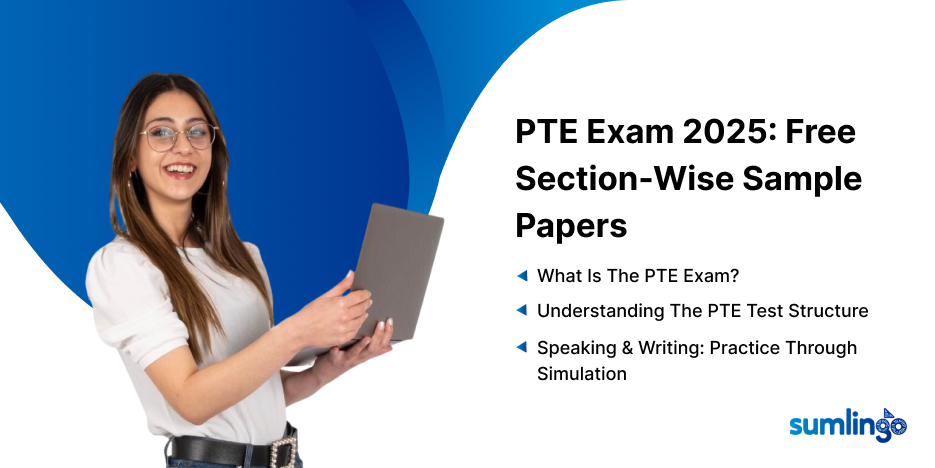When preparing for the PTE writing section, many students focus on vocabulary and grammar. However, scoring well isn’t just about knowing the right words or correct sentence structure. The key to achieving a high score lies in understanding three essential elements: Form, Linguistics, and Structure. These factors are crucial because they directly affect how your responses are scored. Whether you’re writing an essay, a summary, or a written response, each of these elements plays a vital role in the evaluation process. In this blog, we’ll understand what Form, Linguistics, and Structure mean, how they affect your writing score, and offer tips on improving each aspect to help you score better in the PTE writing section.
Are you ready to test your skills?
What is Form in PTE Writing?
In simple terms, form refers to how well you follow the task’s basic requirements. These include the structure, word count, and correct use of punctuation and spelling. Here’s a closer look at what form involves:
- Word Limit: Each writing task has a specific word limit. If you fail to meet the required word count, whether it’s too short or too long, you’ll risk losing points. So, always ensure your response falls within the given range.
- Correct Format: Whether it’s an essay, summary, or another type of writing task, following the proper format is essential. For example, in essays, you need an introduction, body paragraphs, and a conclusion. Writing in the wrong format can lead to a lower score, even if your grammar and vocabulary are perfect.
- Punctuation and Spelling: Mistakes in punctuation or spelling can make your response unclear. Ensure that your punctuation is consistent, and watch out for commonly misspelled words. Poor spelling and punctuation can lower your form score and make your writing difficult to follow.
To score well in this area, practice writing within the required word count and follow the specific task formats. Get familiar with the structure of different writing tasks and make sure you can provide appropriate responses that fit these formats.
What Does Linguistics Mean in PTE Writing?
Linguistics refers to the quality and accuracy of your language. While you may have excellent grammar, the way you use language, your sentence structure, vocabulary choice, and tone also affect your score. Here’s what you need to focus on:
- Grammar Accuracy: This is one of the most crucial aspects. While small grammar mistakes are sometimes acceptable, frequent errors can significantly reduce your score. Pay close attention to verb tenses, subject-verb agreement, and articles.
- Sentence Variety: Good writing isn’t about using long, complicated sentences all the time. A mix of simple, compound, and complex sentences makes your writing more dynamic and easier to read. Practice creating a variety of sentence types to make your writing more engaging.
- Tone and Register: The tone of your writing should match the task type. For example, in academic writing tasks, you should use a formal tone. Avoid informal language unless the task specifically asks for it.
- Smooth Transitions: Using transition words like therefore, however, in addition, and on the other hand will help your writing flow smoothly. These words guide the reader from one idea to the next, creating a logical progression in your writing.
To improve your linguistic score, focus on using correct grammar consistently, vary your sentence structures, and pay attention to the tone required by the task. Additionally, practice using transitional phrases to improve the flow of your writing.
The Importance of Structure in PTE Writing
Structure refers to how well your ideas are organized. Even if your grammar and vocabulary are excellent, a poorly structured response can confuse the reader and lower your score. Here’s what to keep in mind:
- Logical Flow: Your writing should have a clear and logical progression. This means that your ideas should be connected, and the response should follow a natural flow from the introduction to the conclusion.
- Use of Paragraphs: A well-organized response has distinct paragraphs that each present one idea clearly. Whether you’re writing an essay or a short response, break your writing into paragraphs. Avoid long, unbroken blocks of text that make it hard to follow your argument.
- Cohesion and Coherence: Use cohesive devices such as, in conclusion, and as a result to link your ideas. These devices help connect your thoughts and make your response easier to read and understand.
- Clarity: Make sure that your thoughts are expressed clearly. If your ideas are jumbled or hard to follow, your score will suffer, no matter how well you use grammar or vocabulary.
To improve your structure, always start by outlining your response before writing it. Ensure that each paragraph addresses one central idea, and use transitions between paragraphs to guide the reader through your argument.
Scoring Breakdown: How Form, Linguistics, and Structure Impact Your PTE Writing Score
Your PTE writing score is determined by how well you demonstrate form, linguistics, and structure. Here’s how these factors are reflected in the score bands:
- Below 50: At this level, responses often don’t meet the word limit, are poorly structured, and contain frequent grammar and punctuation errors. Improving by learning task formats and practicing basic grammar and sentence structures can help raise your score.
- 50-59: Responses in this range meet the basic task requirements but may lack fluency and contain some recurring grammar issues. Focusing on sentence variety and improving transitions between ideas will help raise your score.
- 60-69: Writing in this range is generally clear, with good grammar and logical flow. To improve further, work on refining your sentence structures and maintaining consistency in tone and transitions.
- 70+: At this level, your writing is well-organized, clear, and accurate. To maintain or improve, continue practicing advanced grammar structures, reading academic materials for inspiration, and proofreading your work carefully.
Mastering form, linguistics, and structure is essential for scoring well in the PTE writing section. By focusing on these three elements, you can ensure your responses meet the exam’s requirements, are easy to follow, and showcase your English proficiency. Practice regularly, use a variety of sentence structures, and make sure your writing is well-organized and clear.
Are you ready to test your skills?
Frequently Asked Questions (FAQ)
1. What is the best way to organize my PTE writing task?
For most writing tasks, aim to follow a clear structure: an introduction, body paragraphs, and a conclusion. This will ensure your ideas are well-organized and logically presented. Each paragraph should focus on one main idea, with clear transitions between them.
2. How do I improve my grammar for the PTE writing section?
Regular practice with sentence building and grammar exercises is essential. Focus on mastering basic grammar rules, such as verb tenses, articles, and prepositions. Use online grammar tools or attend grammar workshops to polish your skills.
3. How do I manage time during the PTE writing section?
Time management is key. Practice writing responses within the allocated time frame. Start by allocating time to plan, write, and review. Make sure to leave a few minutes at the end for proofreading.
4. Can I use informal language in the PTE writing section?
Only if the task explicitly asks for it. Most writing tasks in the PTE require a formal tone, especially in academic or professional contexts. Avoid slang or overly casual expressions unless instructed otherwise.










